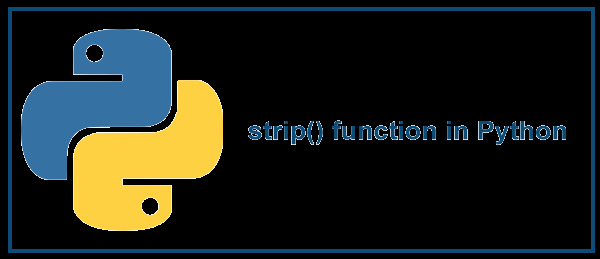strip() 函数是 Python 的预定义库函数。它用于通过删除传递给 strip() 函数的前导和尾随空格、字符和符号来返回原始字符串的副本。换句话说,它是 Python 字符串 strip() 函数,它通过将一组字符指定给 strip() 函数作为参数,从字符串的左端和右端删除字符。默认情况下,如果没有参数传递给 strip() 函数,它会从开始和结束字符串中删除空格。

用法
strip( 'characters' )参数:
- strip ('chars'):strip() 参数是可选参数。因此,如果程序员没有将任何参数传递给 strip() 函数,它将从字符串中删除开始和结束空格。
- 如果给定参数的集合传递给 strip() 函数,它会从原始字符串中删除字符或符号。
返回值:它通过从原始字符串中删除字符集或空格来返回原始字符串的副本。
使用 strip() 函数从给定字符串中删除字符或符号
让我们考虑一个示例,通过从 Python 中的给定字符串中删除前导或尾随字符来执行 strip() 函数。
剥离文件
strinput = " $$$$$ No. 1 Welcome to JAVATPOINT!! No. 1 $$$ "
# use strip() function to remove the set of characters
res = strinput.strip ( ' $No. 10 !' ) # store result into res variable
print ( " Given string is:", strinput)
print ( " After removing the set of characters:", res)
str3 = ' 1 11 111 111 1111 Learn Python Programming Tutorial 1111 111 11 1 '
str4 = str3. strip ( '1' )
print (" \n Given string is ", str3)
print (" Stripping 1 from both ends of the string using strip ('1') function ", str4)
# define new string
str5 = '++++++Python Programming Tutorial****** $$$$$'
print ("\n Given string is = ", str5)
# use strip function to remove the symbols from both ends
str6 = str5. strip ( ' $*+' )
print (" Stripping the '+', '*' and '$' symbols on both sides of the string is = ", str6)输出
Given string is: $$$$$ No. 1 Welcome to JAVATPOINT!! No. 1 $$$
After removing the set of characters: Welcome to JAVATPOINT
Given string is 1 11 111 111 1111 Learn Python Programming Tutorial 1111 111 11 1
Stripping 1 from both ends of the string using strip ('1') function 1 11 111 111 1111 Learn Python
Programming Tutorial 1111 111 11 1
Given string is = ++++++Python Programming Tutorial****** $$$$$
Stripping the '+', '*' and '$' symbols on both sides of the string is = Python Programming Tutorial
使用 strip() 函数从给定的字符串中删除空格
让我们考虑一个示例,通过从 Python 中的给定字符串中删除前导或尾随空格来执行 strip() 函数。
Strip2.py
str1 = ' Welcome to the World! '
# print the original string
print (' Given string is:', str1)
# use strip() function to remove whitespace
str2 = str1.strip()
print(" After removing whitespaces from an original string:", str2)
str3 = ' Learn Python programming '
# print the original string
print (' Given string is:', str3)
# use strip() function to remove whitespace
str4 = str3.strip()
print(" After removing whitespaces from an original string:", str4)输出
Given string is: Welcome to the World! After removing whitespaces from an original string: Welcome to the World! Given string is: Learn Python programming After removing whitespaces from an original string: Learn Python programming
在上面的程序中,我们使用 strip() 函数从给定字符串的开头和结尾删除空格,但它不会删除字符串之间的空格。
使用 strip() 函数从用户获取任何字符串并删除任何字符或符号的程序
程序文件
str1 = input( " Enter the string ") # take a string
print (" Your string is ", str1)
ch = input (" Enter any character or symbol that you don't want to see in the string ")
res = str1.strip (ch)
# print the string after using a strip() method
print (" After performing the strip() function, \n Your string is ", res)输出
Enter the string *** $$ Welcome to JavaTpoint. Learn Python programming !!! && Your string is *** $$ Welcome to JavaTpoint. Learn Python programming !!! && Enter any character or symbol that you don't want to see in the string * $ Wel ! & After performing the strip() function, Your string is come to JavaTpoint. Learn Python programming
为什么使用 Python strip() 函数?
以下是使用python strip函数的原因:
- 它有助于根据传递给 strip() 函数的字符从原始字符串的前导和尾随中删除字符。
- 如果用户没有将任何字符传递给 strip 函数,默认情况下,它只会删除字符串两端的空格。
- 如果原始字符串的开头或结尾没有空格,则返回原始字符串而不对其进行修改。
- 如果传入的字符与原始字符串不匹配,strip 函数返回原始字符串。
结论:
在上面的话题中,我们了解了 Python 库的 strip() 函数。它是一个 strip() 函数,用于去除原始字符串开头和结尾的字符或空格。但是,如果用户没有将任何字符传递给 strip() 函数,它只会从主字符串的开头和结尾删除空格。
相关用法
- Python string strip()用法及代码示例
- Python string.octdigits用法及代码示例
- Python string.whitespace用法及代码示例
- Python string capitalize()用法及代码示例
- Python string.punctuation用法及代码示例
- Python string center()用法及代码示例
- Python str() vs repr()用法及代码示例
- Python strftime()用法及代码示例
- Python str()用法及代码示例
- Python Scipy stats.cumfreq()用法及代码示例
- Python Scipy stats.nanmean()用法及代码示例
- Python Scipy stats.gengamma()用法及代码示例
- Python Scipy stats.dweibull()用法及代码示例
- Python Scipy stats.hypsecant()用法及代码示例
- Python scipy stats.expon()用法及代码示例
- Python Scipy stats.f()用法及代码示例
- Python Scipy stats.genexpon()用法及代码示例
- Python Scipy stats.genextreme()用法及代码示例
- Python Scipy stats.alpha()用法及代码示例
注:本文由纯净天空筛选整理自 strip() function in Python。非经特殊声明,原始代码版权归原作者所有,本译文未经允许或授权,请勿转载或复制。
